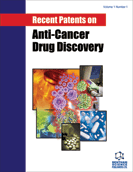
Abstract
Background: Terminalia chebula (T. chebula) comprising chebulinic acid as its principle active constituent is used to cure various diseases. T. chebula and chebulinic acid are used as antimicrobial, antioxidant, antidiabetic, anti-inflammatory, hepatoprotective, antimutagenic, radioprotective, cardioprotective, antiproliferative, antiarthritic, anticaries, and so on.
Objective: The objective of this current study is to give an overview of the recent literature and patents of T. chebula and chebulinic acid including methods of its isolation/extraction and their application in the prevention of various cancers and other diseases.
Methods: Present research and patents highlighting the anti-cancer potential of T. chebula and chebulinic acid have been studied and discussed keeping in view the scientific novelty and impact.
Results: Both T. chebula and chebulinic acid are currently being explored for their anticancer potential in vitro and in vivo. They are either incorporated alone or in combination with other plants or drugs to show their activity and many clinical trials are also going on various potentials of the plant and chebulinic acid. Novel extraction techniques are also explored and patented. Efforts are being made to improve the bioavailability by developing Novel herbal drug delivery systems of the plant extract or chebulinic acid itself.
Conclusion: Anti-cancer potential of T. chebula and chebulinic acid may be well established by promising clinical trials and may open new interventions in various tumors. Clinical trials in conjunction with standard therapies are required to explore and validate the actual potential of T. chebula and chebulinic acid respectively.
Keywords: Anti-cancer, chebulinic acid, extraction, Terminalia chebula, patents, therapy.
[http://dx.doi.org/10.1016/S2221-1691(13)60059-3] [PMID: 23620847]
[http://dx.doi.org/10.3923/ijp.2014.289.298]
[http://dx.doi.org/10.1016/S0378-8741(02)00099-5] [PMID: 12127233]
[http://dx.doi.org/10.1016/j.jep.2009.05.022] [PMID: 19481594]
[http://dx.doi.org/10.1016/S0378-8741(02)00034-X] [PMID: 12065146]
[http://dx.doi.org/10.1515/znc-2001-11-1211] [PMID: 11837686]
[http://dx.doi.org/10.1016/S0378-8741(00)00360-3] [PMID: 11167031]
[http://dx.doi.org/10.1016/j.phymed.2013.01.002] [PMID: 23462212]
[http://dx.doi.org/10.1038/sj.leu.2402945] [PMID: 12835716]
[http://dx.doi.org/10.1517/14728222.2011.645805] [PMID: 22239440]
[http://dx.doi.org/10.1007/s10495-008-0202-0] [PMID: 18392682]
[http://dx.doi.org/10.1002/mc.20654] [PMID: 20572161]
[http://dx.doi.org/10.1016/j.ejphar.2010.08.020] [PMID: 20840847]
[http://dx.doi.org/10.1186/1472-6882-12-22] [PMID: 22443687]
[http://dx.doi.org/10.1007/s00204-006-0139-4] [PMID: 16932919]
[http://dx.doi.org/10.1002/jlac.19576090117]
[http://dx.doi.org/10.1002/jlac.19576090118]
[http://dx.doi.org/10.1039/j39670002381]
[http://dx.doi.org/10.1248/cpb.28.3713]
[http://dx.doi.org/10.1002/jlac.19576090119]
[http://dx.doi.org/10.1002/jlac.19515710102]
[http://dx.doi.org/10.1002/jlac.19677060119]
[http://dx.doi.org/10.1016/j.prmcm.2022.100163]
[http://dx.doi.org/10.1002/jssc.200600089] [PMID: 16922284]
[http://dx.doi.org/10.1002/jssc.201900356] [PMID: 31444948]
[http://dx.doi.org/10.1002/jssc.201501358] [PMID: 26864462]
[PMID: 15620182]
[http://dx.doi.org/10.1002/pca.823] [PMID: 16042149]
[PMID: 12575084]
[http://dx.doi.org/10.1002/jssc.200401741] [PMID: 15387468]
[http://dx.doi.org/10.1016/j.jep.2013.02.025] [PMID: 23506992]
[http://dx.doi.org/10.4103/0250-474X.57286] [PMID: 20502543]
[PMID: 12580059]
[http://dx.doi.org/10.1016/j.sjbs.2018.02.013] [PMID: 31762663]
[http://dx.doi.org/10.1093/chromsci/bmu096] [PMID: 25190275]
[http://dx.doi.org/10.4103/0974-8490.182919] [PMID: 27365992]
[http://dx.doi.org/10.1007/s12262-020-02388-4]
[http://dx.doi.org/10.3322/caac.21492] [PMID: 30207593]
[http://dx.doi.org/10.1111/j.1743-7563.2008.00191.x]
[http://dx.doi.org/10.1002/cbin.11463] [PMID: 32902904]
[http://dx.doi.org/10.1080/01635581.2021.1903948] [PMID: 33821702]
[http://dx.doi.org/10.1007/s12010-022-04301-z] [PMID: 36585552]
[http://dx.doi.org/10.1016/j.heliyon.2022.e10220] [PMID: 36051270]
[http://dx.doi.org/10.1002/ptr.5927] [PMID: 28921713]
[http://dx.doi.org/10.1371/journal.pone.0286274] [PMID: 37256897]
[http://dx.doi.org/10.1016/j.canlet.2005.10.044] [PMID: 16338066]
[http://dx.doi.org/10.3923/ijp.2021.229.242]
[http://dx.doi.org/10.3892/or.7.6.1221] [PMID: 11032918]
[http://dx.doi.org/10.1007/BF02979144]
[http://dx.doi.org/10.1016/j.homp.2016.02.004] [PMID: 27914571]
[http://dx.doi.org/10.1186/1472-6882-14-319]
[http://dx.doi.org/10.3109/13880209.2014.962058] [PMID: 25625850]
[http://dx.doi.org/10.1111/jfbc.13521] [PMID: 33043490]
[http://dx.doi.org/10.1080/07391102.2016.1244493] [PMID: 27691720]
[http://dx.doi.org/10.1177/1934578X1000500417] [PMID: 20433076]
[http://dx.doi.org/10.1007/s43188-021-00092-3] [PMID: 35419271]
[http://dx.doi.org/10.1186/s13075-020-02370-1] [PMID: 33225986]
[http://dx.doi.org/10.1002/ptr.3504] [PMID: 21538627]



























